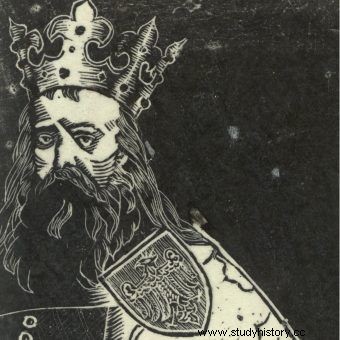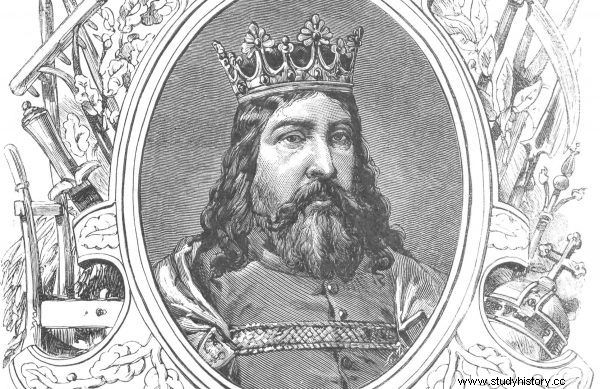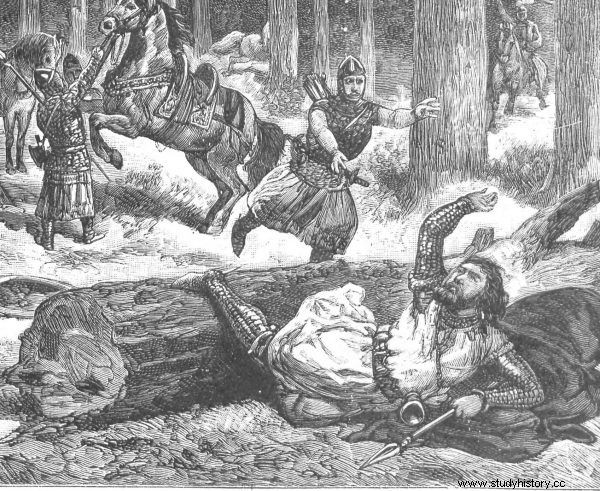Casimir the Great did not listen to anyone. Neither when he was warned against dangerous entertainment, nor on the way back, when the wounded man ignored all the exhortations of the courtiers and doctors.
For the old king Casimir the Great, nothing was more important than having a son. He has had three marriages, double bigamy lawsuits and more than one erotic scandal. But he still had no legal male heir. The monarch's last wife - the Żagań princess Jadwiga - gave birth to three children as a teenager. However, they were only daughters.

Portrait of Casimir the Great made by Tadeusz Cieślewski according to the pattern of Jan Matejko. 1924
Anna was born probably in 1366, Kunegunda in 1367 or 1368. The last one was named after both her mother and the mother of King Jadwiga. She was born in 1369 or 1370. Kazimierz was devastated by the news of another failure. Instead of with his wife and an unwanted (because he was not endowed with the gender he expected) child, he spent his time playing with the courtiers.
"Significant cut to the left shin"
In the late summer of 1370, he went to the vicinity of Radomsko, where he had a luxuriously furnished manor house in the town of Przedbórz. To make his escapade pleasant, he decided to go hunting. Apparently, the servants advised him not to take this step - either because of the feast of the Nativity of the Virgin Mary on the same day, or because of some urgent matters of a state nature. The sixty-year-old, however, insisted. He dreamed of chasing a deer and was not going to listen to anyone.

Casimir the Great in the image of Ksawery Pilati. Illustration from the end of the 19th century
He jumped on his horse and went deep into the forest. When he returned, his hunting companions had to support him. The king's horse, chasing after the beast, overturned, and the king himself suffered "quite a wound in the left shin." The wound began to heal quickly, and although there was a slight fever with it, no one expected any trouble for it. At least not at first.
A prescription for health? Boiling bath and icy stream water
After only a few days, Kazimierz's condition deteriorated drastically. The ruler, as always, did not allow himself to be reasoned. Ignoring the doctors' admonitions, he went to the bathhouse for a hot bath even before the leg wound had healed. He had barely left the tub and had suffered a new, much stronger fever than before. Despite his weakness, he continued his journey towards Kraków. On the way - etched, as the chronicler put it, with internal fire - he stepped down from the wagon and ... drank in great gulps of icy water from the stream.

A royal hunting accident in the image of Ksawery Pilati. Illustration from the end of the 19th century
From then on, the fever almost never left him. The moments of improvement were brief, and every time the king regained his form for a moment, instead of taking any more rest, he jumped up from the bed and ordered the horses to be harnessed. He had a laxative once and got on the cart, believing he was completely recovered. Doctors advised moderately, but he stubbornly ran towards the capital.
You will live, King, long years
When the retinue reached the city, the king's condition was so bad that the monarch was not even able to recognize that he was at his destination. He asked doctors where he was, he was delirious, he was sweating seven times. When he sobered up a bit, the frightened doctors persuaded him, one by one, that he was safe and that he would live for many years.
Nevertheless, the king proceeded to write the will. Rightly. By God's grace, the king of Poland, lord and heir of the lands of Krakow, Sandomierz, Sieradz, Łęczyca, Kujawy, Pomerania and Rus, Kazimierz, son of Władysław "passed away happily to Christ" surrounded by "many people of the nobility and clergy."
Selected bibliography:
The article was based on materials collected by the author during the work on the book "Ladies of the Polish Empire. The Women Who Built a Power " . Some of these items are shown below. Full bibliography in the book.
- Dąbrowski J., Elżbieta Łokietkówna 1305-1380 , Universitas, Krakow 2007.
- Dąbrowski J., The last years of Ludwik the Great 1370-1382 , Universitas, Krakow 2009.
- Kiryk F., The Great King and His Successor , National Publishing Agency 1992.
- Kurtyka J., The reborn kingdom. The monarchy of Władysław Łokietek and Casimir the Great in the light of more recent research , Societas Vistulana, Krakow 2001.
- Śliwiński J., The marriages of Casimir the Great. A study in the field of morality and ethics of the royal court in Poland in the 14th century , Pedagogical University in Olsztyn, Olsztyn 1987.
- Wyrozumski J., Casimir the Great , Ossolineum, Wrocław 2004.
